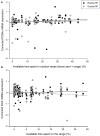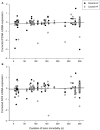Cell Proliferation in the Adult Chicken Hippocampus Correlates With Individual Differences in Time Spent in Outdoor Areas and Tonic Immobility
- PMID: 33005647
- PMCID: PMC7479223
- DOI: 10.3389/fvets.2020.00587
Cell Proliferation in the Adult Chicken Hippocampus Correlates With Individual Differences in Time Spent in Outdoor Areas and Tonic Immobility
Abstract
Access to outdoor areas is provided as a means of enhancing welfare in commercial systems for laying hens (Gallus gallus domesticus), but substantial individual differences exist in their proportional use. Baseline cell proliferation levels of Adult Hippocampal Neurogenesis (AHN) have been associated with individual differences in reactive vs. proactive coping style, and in both mammals and birds, AHN is upregulated by positive experiences including environmental enrichment and exercise. We thus sought to explore whether individual differences in use of outdoor areas and in tonic immobility responses (indicative of fearfulness) were associated with hippocampal cell proliferation and neuronal differentiation. Radio frequency identification technology was used to track the ranging behavior of 440 individual focal hens within a commercially-relevant system over a 72-days period, after which tonic immobility durations were measured. Following hippocampal tissue collection from 58 focal hens, proliferation and neuronal differentiation were measured through quantitative PCR for proliferating cell nuclear antigen (PCNA) and doublecortin mRNA, respectively. Individual differences in tonic immobility duration positively correlated with PCNA expression over the whole hippocampal formation, while greater time spent in outdoor areas (the grassy range and stone yard) was associated with higher proliferation in the rostral subregion. Basal proliferation in the chicken hippocampal formation may thus relate to reactivity, while levels in the rostral region may be stimulated by ranging experience. Doublecortin expression in the caudal hippocampus negatively co-varied with time on the grassy range, but was not associated with tonic immobility duration. This suggests that ranging outside may be associated with stress. Within laying hen flocks, individual differences in hippocampal plasticity thus relate to coping style and use of external areas.
Keywords: Gallus gallus domesticus; adult neurogenesis; animal welfare; avian brain; free-range laying hens; hippocampal formation; individual differences.
Copyright © 2020 Armstrong, Voelkl, Voegeli, Gebhardt-Henrich, Guy, Sandilands, Boswell, Toscano and Smulders.
Figures



Similar articles
-
Relationships between range access as monitored by radio frequency identification technology, fearfulness, and plumage damage in free-range laying hens.Animal. 2016 May;10(5):847-53. doi: 10.1017/S1751731115002463. Epub 2015 Nov 23. Animal. 2016. PMID: 26593871
-
Application of open field, tonic immobility, and attention bias tests to hens with different ranging patterns.PeerJ. 2019 Nov 25;7:e8122. doi: 10.7717/peerj.8122. eCollection 2019. PeerJ. 2019. PMID: 31788364 Free PMC article.
-
Relationship between welfare and individual ranging behaviour in commercial free-range laying hens.Animal. 2018 Nov;12(11):2356-2364. doi: 10.1017/S1751731118000022. Epub 2018 Jan 24. Animal. 2018. PMID: 29362002
-
Welfare implications of avian osteoporosis.Poult Sci. 2004 Feb;83(2):184-92. doi: 10.1093/ps/83.2.184. Poult Sci. 2004. PMID: 14979568 Review.
-
Basal and stress-induced differences in HPA axis, 5-HT responsiveness, and hippocampal cell proliferation in two mouse lines.Ann N Y Acad Sci. 2004 Jun;1018:255-65. doi: 10.1196/annals.1296.030. Ann N Y Acad Sci. 2004. PMID: 15240376 Review.
Cited by
-
Commercial layer hybrids kept under organic conditions: a comparison of range use, welfare, and egg production in two layer strains.Poult Sci. 2022 Sep;101(9):102005. doi: 10.1016/j.psj.2022.102005. Epub 2022 Jun 13. Poult Sci. 2022. PMID: 35841633 Free PMC article.
-
Poor body condition is associated with lower hippocampal plasticity and higher gut methanogen abundance in adult laying hens from two housing systems.Sci Rep. 2022 Sep 15;12(1):15505. doi: 10.1038/s41598-022-18504-1. Sci Rep. 2022. PMID: 36109559 Free PMC article.
-
Mind the ramp: Association between early life ramp use and spatial cognition in laying hen pullets.PLoS One. 2024 Apr 26;19(4):e0302454. doi: 10.1371/journal.pone.0302454. eCollection 2024. PLoS One. 2024. PMID: 38669289 Free PMC article.
-
Environmental Enrichment and Its Benefits for Migraine: Dendritic Cell Extracellular Vesicles as an Effective Mimetic.J Cell Immunol. 2021;3(4):215-225. J Cell Immunol. 2021. PMID: 34337600 Free PMC article.
-
Outdoor access versus conventional broiler chicken production: Updated review of animal welfare, food safety, and meat quality.Poult Sci. 2025 Apr;104(4):104906. doi: 10.1016/j.psj.2025.104906. Epub 2025 Feb 17. Poult Sci. 2025. PMID: 39985895 Free PMC article. Review.
References
-
- Knierim U. Animal welfare aspects of outdoor runs for laying hens: a review. NJAS. (2006) 54:133–45. 10.1016/S1573-5214(06)80017-5 - DOI
-
- Gebhardt-Henrich SG, Toscano MJ, Fröhlich EKF. Use of outdoor ranges by laying hens in different sized flocks. Appl Anim Behav Sci. (2014) 155:74–81. 10.1016/j.applanim.2014.03.010 - DOI
LinkOut - more resources
Full Text Sources
Miscellaneous

